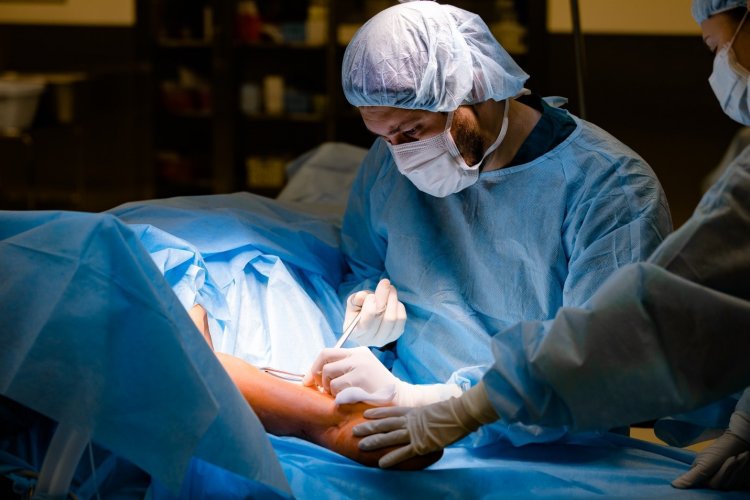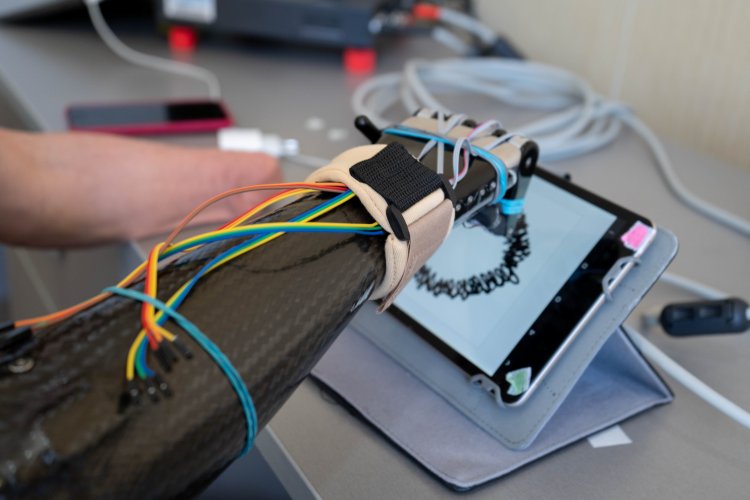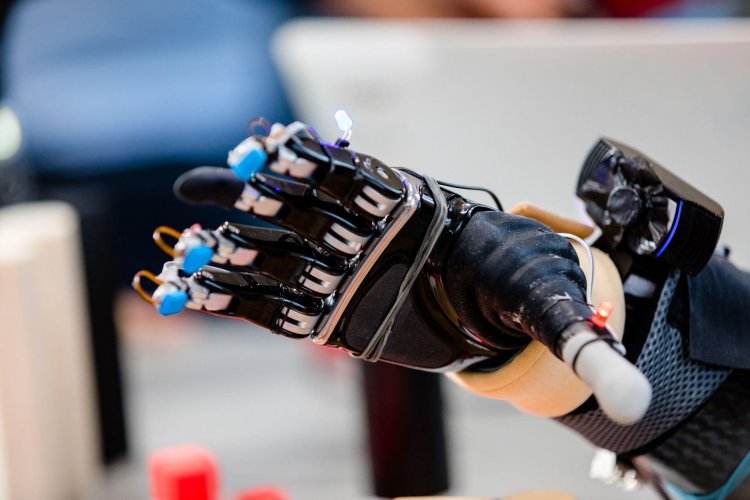Skolkovo resident company Motorica, the Far Eastern Federal University, and Skoltech have completed the first phase of their joint study on bionic hand sensitization and phantom pain management. The surgical team implanted electrodes near the peripheral nerves of patients and achieved enduring phantom pain reduction under electrical stimulation. The surgery was followed by a series of sensorimotor tests with haptic communication in the form of invasive and noninvasive electrical stimulation.
The study, which is unique for Russia, confirmed that invasive neurophysiological research can be successfully performed using domestic facilities. The team’s findings will help bring advanced neurotechnology to clinics and use it for phantom pain management, while also making prosthetics feel more natural by simulating the sense of touch.
The collaborative project had been gaining momentum for four years before the team launched its first test study. The surgery, rehabilitation, and follow-up research were carried out at the Far Eastern Federal University Medical Center. Motorica selected the patients and provided technological support, while the Skoltech team took care of research tasks.
Two men with amputated limbs from the Russian towns Lermontov and Roslavl were selected as the first patients based on fairly rigorous criteria: They had to be aged 18 or older, with amputated hands and persistent phantom pain.
During surgery on the first patient on Nov. 26, the doctors implanted two electrodes on the median nerve. In the second patient, three electrodes were placed on the radial, ulnar, and median nerves. Both operations were performed by the FEFU Medical Center’s surgical team led by Artur Biktimirov, a functional neurosurgeon at the FEFU Medical Center and expert at the FEFU National Technology Initiative Center for VR/AR Neurotechnology. Leveraging its extensive experience in this kind of breakthrough projects, the team routinely performs high-tech surgical treatment, conducts in-house research and introduces advanced treatment methods at the university clinic. The center’s neurosurgeons have already implanted more than 450 spinal cord and brain stimulation systems in patients with Parkinson’s disease, epilepsy, and cerebral palsy. After each operation, the team runs tests and monitors the adaptation process.
On Nov. 27, the team hooked up the electrodes and conducted the first test stimulation. The adopted phantom pain management strategy relied on a series of small electrical impulses generated by a wearable device and delivered through electrodes placed near the targeted peripheral nerves over the entire duration of the study, except when sensorimotor tests were being done. The patients recorded their sensations in a journal to enable retrospective monitoring of the progress in alleviating phantom pain.
Bionic hand sensitization involved several steps: sensitivity mapping of the phantom limb, selecting the stimulation parameters for mimicking the sense of touch and compression, and performing tests with haptic communication through electrical stimulation.
The second patient demonstrated a steady reduction in phantom pain from day one. His subjective feel of the phantom hand exhibited an unexpected feature: After an initial easing of the phantom burning sensation, he reported touch and finger flexing sensations. In the first patient, phantom pains did not disappear completely but decreased by 40%-70%. Also, during electrical stimulation, he reported a sensation of general compression in the fingers and that of making a fist. The team used this persisting “fist” sensation caused by stimulation to check if the patient could tell the size of objects he held in the prosthetic hand. Wearing a mask and unable to see the bionic hand, he actually managed to correctly perceive the size of the objects.
Although the findings are yet to be analyzed by the team of Professor Mikhail Lebedev, who heads Vladimir Zelman Center for Neurobiology and Brain Rehabilitation at Skoltech, the project team looks forward to expanding the scope of its research by engaging more participants in 2022.
The funding for the study reported in this story came from a round of investment that Motorica received from the Far East High Technology Fund and the Russian Direct Investment Fund in January 2021.
Comments
Ilya Chekh, co-founder and CEO of Motorica:
“Our main goal was to check our hypothesis and answer the question, ‘Can invasive stimulation of the peripheral nervous system generate sensory response so that the patient could both feel an object in his bionic hand and knew how his fingers were positioned?” We have fully proved that this is possible, technologically and physiologically, and this opens new horizons for research. After this trial phase, we will continue our collaboration with the FEFU Medical Center and INTC Russky on Russky Island in Vladivostok to build a cybermedical cluster, a special economic and legal zone for projects and companies pursuing invasive research and technology. We intend to create a community of Russian developers and engineers, and bring in development institutions and international partners.”
Artur Biktimirov, functional neurosurgeon at the FEFU Medical Center and expert at the FEFU NTI Center for VR/AR Neurotechnology:
“We succeeded in reducing phantom pain and achieved both pressure sensation and perceptual sensitivity in both patients. They could tell whether the prosthetic hand was closed or open and whether they were holding an object in it. About a dozen teams around the world are working on this problem, but none has a ready solution yet. The Russian team is intending to ramp up its research efforts. Right now, we are analyzing the results and planning our next steps for the spring of 2022.”
Yury Matvienko, head of invasive research at Motorica:
“The first-phase outcomes prove that our hypotheses work. Although we cannot yet ensure 100% sensitization, we now know it is possible. This gives us an understanding of our tasks for the next phase and the research protocol we need to prepare. Also, we will update our patient selection methodology for the sake of research integrity.”
Mikhail Sintsov, junior research scientist at Vladimir Zelman Center for Neurobiology and Brain Rehabilitation at Skoltech:
“Considering the limited technological capabilities we used, seeing the patients steadily develop closed-fist and object-holding sensations in response to stimulation was quite a surprise. This effect may be associated with the activation of proprioceptive pathways, but that remains to be verified. The sensitization results achieved via invasive technology are truly unique, and it’s not something we could reproduce with noninvasive epidermal stimulation and stump mapping. It is also unique because the stimulation-induced sensations closely matched the hand’s movements — a similarity we successfully used in one of the object size tests.”
Gurgen Sogoyan, PhD student at Vladimir Zelman Center, Skoltech:
“In our experiment, we succeeded in generating sensations that the patients had not experienced since the injury. Both patients said that their hands seemed to ‘come to life.’ Touch, pressure, vibration sensations, and motion intentions returned after the mapping, which helped find the appropriate electrical stimulation settings. Varying the stimulation parameters changed both the quality and the location of the sensations that spread all over the palm from the fingertips to the wrist. Such fine-tuning became possible thanks to the invasive approach.”
Professor Mikhail Lebedev, director of Vladimir Zelman Center, Skoltech:
“Our results have surpassed all expectations. Stimulating the hand through the electrodes implanted by Artur Biktimirov helped generate what felt like tactile sensations in the hand (which was actually amputated). Moreover, the patients could rely on these sensations in the active touch paradigm, for example, in scanning virtual tactile objects. This stimulation-induced artificial-sensation functionality helped replace phantom pain with nearly normal sensitivity. Our researchers, Mikhail Sintsov and Gurgen Sogoyan, carefully mapped the induced artificial sensations, selected optimal stimulation parameters, and recorded electroencephalograms with and without phantom pains. Our colleagues, Daria Kleeva and Kirill Polovnikov, will continue to analyze these data but their preliminary review already suggests that the phantom pain state is clustered in the multidimensional neuronal space. This finding is important for understanding the mechanisms of neuropathic pain and its objective monitoring. Overall, this study is a major breakthrough in neurotechnology, which will help many amputees and patients with neurological injuries.”
Contact information:
Skoltech Communications
+7 (495) 280 14 81



